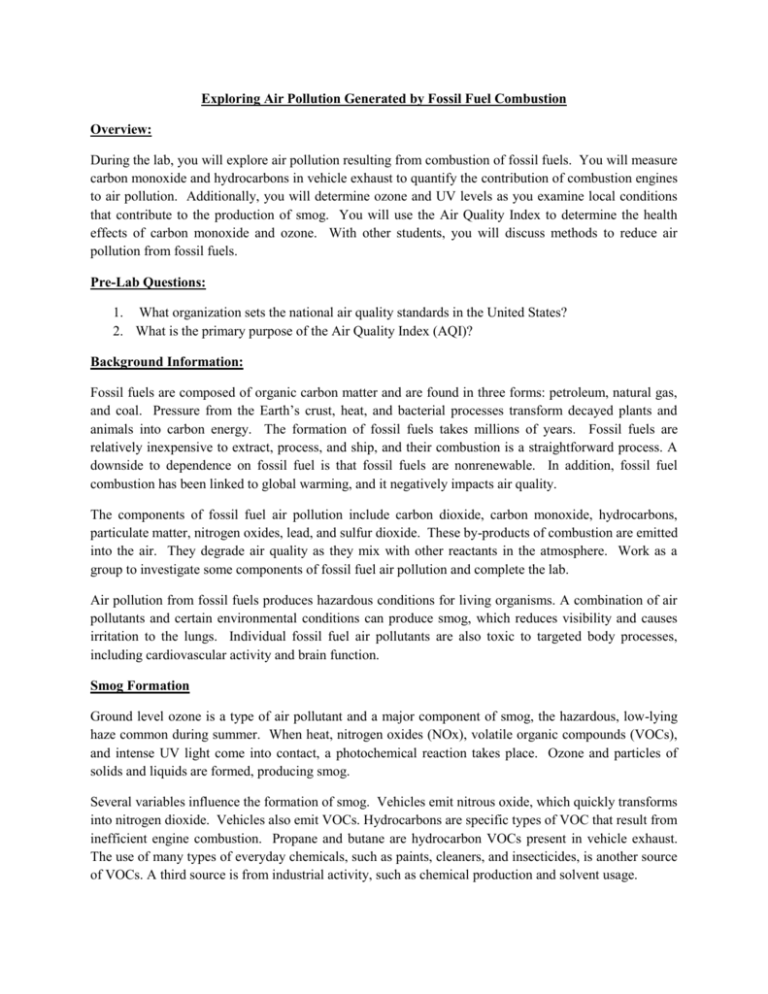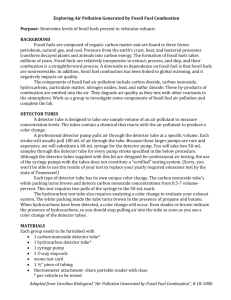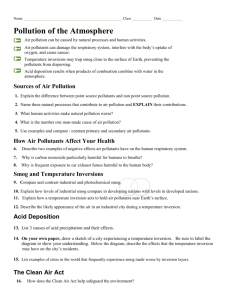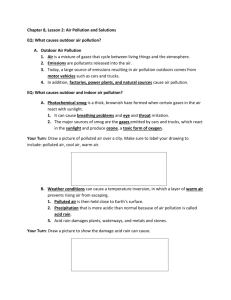Exploring Air Pollution Generated by Fossil Fuel Combustion
advertisement

Exploring Air Pollution Generated by Fossil Fuel Combustion Overview: During the lab, you will explore air pollution resulting from combustion of fossil fuels. You will measure carbon monoxide and hydrocarbons in vehicle exhaust to quantify the contribution of combustion engines to air pollution. Additionally, you will determine ozone and UV levels as you examine local conditions that contribute to the production of smog. You will use the Air Quality Index to determine the health effects of carbon monoxide and ozone. With other students, you will discuss methods to reduce air pollution from fossil fuels. Pre-Lab Questions: 1. What organization sets the national air quality standards in the United States? 2. What is the primary purpose of the Air Quality Index (AQI)? Background Information: Fossil fuels are composed of organic carbon matter and are found in three forms: petroleum, natural gas, and coal. Pressure from the Earth’s crust, heat, and bacterial processes transform decayed plants and animals into carbon energy. The formation of fossil fuels takes millions of years. Fossil fuels are relatively inexpensive to extract, process, and ship, and their combustion is a straightforward process. A downside to dependence on fossil fuel is that fossil fuels are nonrenewable. In addition, fossil fuel combustion has been linked to global warming, and it negatively impacts air quality. The components of fossil fuel air pollution include carbon dioxide, carbon monoxide, hydrocarbons, particulate matter, nitrogen oxides, lead, and sulfur dioxide. These by-products of combustion are emitted into the air. They degrade air quality as they mix with other reactants in the atmosphere. Work as a group to investigate some components of fossil fuel air pollution and complete the lab. Air pollution from fossil fuels produces hazardous conditions for living organisms. A combination of air pollutants and certain environmental conditions can produce smog, which reduces visibility and causes irritation to the lungs. Individual fossil fuel air pollutants are also toxic to targeted body processes, including cardiovascular activity and brain function. Smog Formation Ground level ozone is a type of air pollutant and a major component of smog, the hazardous, low-lying haze common during summer. When heat, nitrogen oxides (NOx), volatile organic compounds (VOCs), and intense UV light come into contact, a photochemical reaction takes place. Ozone and particles of solids and liquids are formed, producing smog. Several variables influence the formation of smog. Vehicles emit nitrous oxide, which quickly transforms into nitrogen dioxide. Vehicles also emit VOCs. Hydrocarbons are specific types of VOC that result from inefficient engine combustion. Propane and butane are hydrocarbon VOCs present in vehicle exhaust. The use of many types of everyday chemicals, such as paints, cleaners, and insecticides, is another source of VOCs. A third source is from industrial activity, such as chemical production and solvent usage. Smog formation is also affected by environmental factors such as wind, temperature, topography, and ultraviolet light. An enclosed region such as a valley has reduced wind levels, allowing smog to accumulate. High ambient temperatures tend to increase smog formation. UV light reacts with fossil fuel pollution to form smog. Cloud cover and other changes in the weather, the tilt of the Earth at different times of the year, and the daily changes in position of the sun in the sky affect UV light intensity. Any decrease in the naturally occurring ozone in the upper atmosphere allows more UV radiation to penetrate. In the past, this protective ozone layer was reduced by human activities, mainly by chlorofluorocarbons that were used in coolants for many years. There is evidence that the layer has been recovering since those chemicals were replaced by alternatives. The effects of smog on human health on human health vary. Common effects are nose and throat irritation. A severe response includes lung inflammation. If the damage happens over long periods of time, lung function may be reduced permanently. The elderly, children, and people with lung ailments are particularly vulnerable to smog. Air Pollution Monitoring System: The Air Quality Index In cities in the United States, several air pollutants are monitored because of their impact on clean air pollutants are monitored because of their impact on clean air, and their levels are monitored and forecast daily. The monitoring system, called the Air Quality Index (AQI), is managed by the Environmental Protection Agency (EPA). Six major pollutants are included in the AQI: particulate matter, sulfur dioxide, carbon monoxide, nitrogen dioxide, lead, and ozone. Projected pollution concentrations are scaled from 0-500, and the associated threats to human health are also provided. Other countries use similar ratings to inform the public of air pollution levels. Air Quality Index (AQI) Values Levels of Health Concern Colors When the AQI is in this range this color Air quality conditions are as symbolized by this color 0-50 51-100 101-150 151-200 201-300 301-500 Good Moderate Unhealthy for Sensitive Groups Unhealthy Very Unhealthy Hazardous Green Yellow Orange Red Purple Maroon In this lab, you will measure several air pollutants and the environmental factors that influence air quality. Detector Tubes A detector tube is designed to take one sample volume of an air pollutant to measure concentration levels. The tubes contain a chemical that reacts with the air pollutant to produce a color change. A professional detector pump pulls air through the detector tube at a specific volume. Each stroke pulls 100 mL of air through the tube. Because these pumps are expensive, we substitute a 60 mL syringe for the detector pump. You will take two 50 mL samples through the detector tube for every pump stroke specified in the manufacturer’s test procedure. Comparison tests indicate that the syringe method is comparable to the use of the detector pump. Although the detector tubes supplied with the kit are designed for professional air testing, the use of the syringe pumps with these tubes does not constitute a “certified” testing system. Each type of detector tube has its own unique color change. The carbon monoxide tube’s white packing turns brown and detects carbon monoxide concentrations from 0.5-7 volume-percent. This test requires two pulls of the syringe to the 50 mL mark. (You must expel the air you took in after the first pull, because the syringe can hold only 60 mL of air.) The hydrocarbon test also requires analyzing a color change to evaluate an exhaust air stream. The white packing inside the tube turns brown in the presence of propane and butane. Note the volume of exhaust that is pulled in by the syringe to start the color change. The color change does not have to match the brown standard exactly. Shades of brown indicate the presence of hydrocarbons. Data collected on exhaust may vary because of air pressure or temperature. It is best to perform exhaust tests at the same time if you wish to do a vehicle comparison. Materials (per student group): Carbon monoxide detector tube Hydrocarbon detector tube Syringe pump 3-2ay stopcock Ozone test card 1 ½” piece of tubing Thermometer Resealable plastic bag Procedure: Conduct the instructions provided below and fill in the chart in your quadrille. At the end of the data collection, you will have the following measurement readings: ozone, ultraviolet radiation, detector tube concentrations (carbon monoxide and hydrocarbons), and outdoor temperature. Proceed to the lab discussion on smog formation and the effects of air pollution on health. After you have read the discussion, answer the assessment questions. Air Pollution Variables Table Variable Ozone (ppm) Ultraviolet radiation (index) Carbon monoxide (ppm) Hydrocarbons (mL) Ambient temperature (°Celsius) Variable Concentration or Degree Time Sample Ambient Ozone Based upon prior knowledge, pick a location that your group believes would have a high ozone reading. Tape the ozone card at eye level, in a location that will stay out of the sun for 1 hour. Record the start time and leave for an hour. After the reaction time is up, record the end time and put the ozone card into a plastic bag with a slip of paper recording the date, time, and location. Keep the test card with your group for later analysis during the air pollutant calculations. Determine the Current Index of Ultraviolet Radiation Your instructor will pass around one UV indicator card to the class groups. Observe the color of the indicator and match it to the color scale on the card. Record the time and UV level in your lab notebook. Measure Vehicle Emissions List the make, model, and year of the vehicle. After recording the data, prepare the gas detector syringe. Connect the 3-way stopcock to the pump and add the piece of tubing to the stopcock (see figure below). Now, start the car and proceed through the directions for each test. Note: Take the air pollutant readings no more than 1 inch from the mouth of the tail pipe. Use caution; the tailpipe is very hot. Carbon monoxide (CO) sample 1. Connect the CO gas detector tube to the piece of tubing so that the arrow on the detector tube points toward the syringe pump. 2. Draw one air stroke sample using the following steps. a. Turn the stopcock arm toward the unused stopcock stem. b. Place the open end of the gas detector tube into the exhaust airstream. At a reasonable rate, draw 50 mL of air into the syringe. Have a member of the group record the start time. c. Release the plunger. Note: If a partial vacuum is created, the plunger will draw back toward the gas detector tube. Wait until the plunger has stopped moving and then continue to pull back to the 50 mL mark, this time drawing the air sample through more slowly. d. Turn the stopcock arm toward the tube and expel the air out the side opening to clear the pump. (Make sure the stopcock arm is pointed correctly. Air must not pass back through the detector tube.) 3. Repeat steps 2a-d. 4. Remove the gas detector tube from the piece of tubing. 5. Observe the percent volume at the point where the color change stops. In your quadrille, record the concentration of the CO. If the color change line is slanted, take the value at the middle of the slanted region. Remember, Carbon monoxide is tested by taking in two complete, 50 mL syringe strokes. Hydrocarbon (HC Sample 1. Connect the HC gas detector tube to the tubing so that the arrow on the detector tube points toward the syringe pump. 2. Turn the stopcock arm toward the unused stopcock stem. Place the open end of the gas detector tube into the exhaust airstream. At a reasonable rate, draw air into the syringe until you see a color change. Have a member of the group record the start time. 3. In your quadrille, record the volume of air that was needed to see the color indicator. Remember, hydrocarbon is tested by taking in exhaust until a color change takes place. The volume of exhaust that brings about the color change is recorded. Ambient Temperature Use the temperature probe and record the current temperature in your quadrille. Discussion Questions: In your lab groups, collaborate about the repercussions of air pollution. Write down the consensus of your discussion in your quadrille to each of the following. 1. List the effects of poor air quality on individuals and on a community. Think about the impacts on the segments of the population most vulnerable to unhealthy air conditions (children, people with respiratory illnesses, and the elderly). 2. Provide two changes a family might have to make in order to accommodate a member with a long-term illness caused by air pollution. 3. Provide two examples of the effects of poor air on society. 4. Write a summary statement about conserving fossil fuel. Analysis Questions: 1. Convert the carbon monoxide reading to ppm.. Use the relationship, 1 volume-percent = 10,000 ppm. 2. How many times higher is the CO in your sample than at the upper limit of CO in good air as defined by the AQI? 3. Look at another group’s results for hydrocarbons. Did you have similar volumes? Provide the two groups’ hydrocarbon data in your answer and a possible reason for a similarity or difference. 4. Ground level ozone and UV levels vary depending on location and human activity. a. Provide an explanation for the results of your samples. Did your results indicate a relationship between UV intensity and ozone levels? If so, what is it? b. Give specific examples from your area that influence ozone formation. c. Provide factors that could have influenced the UV intensity during the lab. 5. Draw a diagram that shows the interactions that produce smog in an area. Include in your diagram the human activities, the specific air pollutants, and other conditions that are required for smog formation. Also describe ways to reduce smog by focusing on its components.








